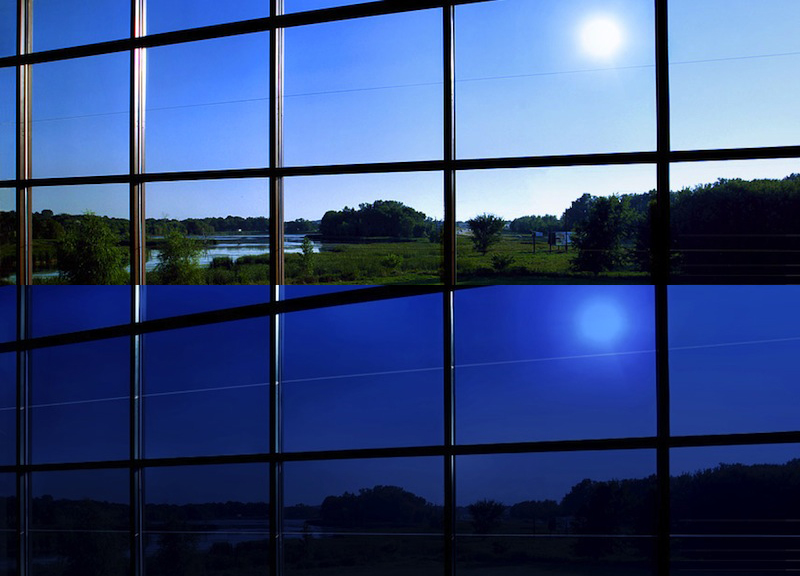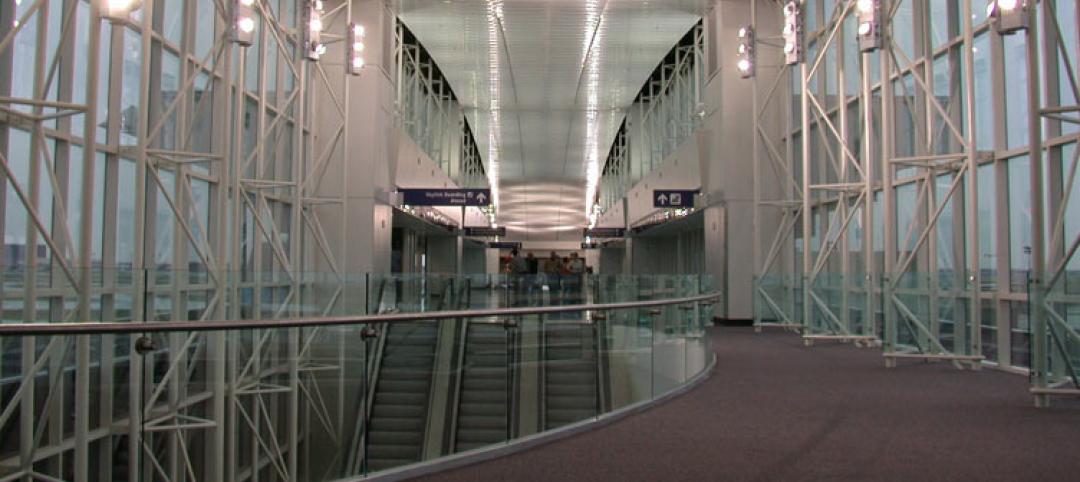New glazing technology is rapidly unfolding. Currently available technologies are seeing performance gains, and cutting-edge products and systems continue to gain a foothold in the mainstream.
Examples of such technologies include:
1. State-of-the-art IGUs. In addition to construction improvements like warm-edge spacers, IGUs are beginning to benefit from alternatives to gas fills. Aerogel insulation, made of synthetic solids that consist almost entirely of air, exhibits extremely low thermal conductivity. Some aerogels can be integrated with polycarbonate sheets to form a translucent cladding material, while others, such as silica aerogels in granular form, can fill the spaces between the glass lites of insulating units, says Ajla Aksamija, PhD, LEED AP BD+C, CDT, Building Technology Researcher with design firm Perkins+Will.
Aksamija also mentions vacuum-insulated glazing (VIG) units. “These units use a vacuum between lites of glass to raise the assembly’s thermal resistance,” she says. With no gas or fill, conduction and convection are virtually eliminated, which also allows the space between the lites (and total glazing thickness) to be greatly reduced, enhancing design flexibility. Patterson notes that vacuum glazing holds the most promise for producing vision glass with a U-factor good enough to justify continuing to build highly glazed facades. He cautions, however, that “a viable solution for widespread application seems to remain beyond the horizon.”
2. Electrochromic glass. Often called smart glass, electrochromic glazing alters its transmittance characteristics when an electrical current is applied, through the use of a specialized lamination that essentially integrates shading into the glazing unit. For instance, one type of smart glass appears frosted until the current is applied, at which point it becomes nearly transparent.
This technology has been in the works for some time, but cost has been a drag on broad market acceptance. There have been problems with the sealants, which are part of the system that carries the electrical current, says Joshua Zinder, AIA, Founding Principal of Joshua Zinder Architecture + Design, who has worked with the products on several occasions.
“A broken seal means a lost electrical connection in the lamination field, which means a loss of the electrochromic functionality in one or more adjacent panels,” he warns, but manufacturers are working to address this problem. “Electrochromic glazing appears to be on the verge of widespread adoption,” says Mic Patterson, Vice President of Strategic Development for Enclos. “The industry has recently invested in the manufacturing infrastructure necessary to produce materials with the right combination of aesthetic and performance attributes at a tolerable price point. These dynamic glazing materials still leave the problem of thermal performance.” Nevertheless, more use of smart glass is likely due to its flexible VLT, which can be integral to daylighting strategies that reduce illumination loads.
3. Building-integrated photovoltaics. In recent years, BIPV systems have shown signs of living up to their promise. With improvements in thin-film PV products to performance levels needed for use in vision glazing, they are getting closer to those of solid solar cells, used in spandrels and shading devices.
Façade orientation and inclination angle are both crucial to the successful integration of PV technology, and the improvement of thin films means that more of a project’s façade area can be integrated for solar harvesting without sacrificing transparency or translucence. Of course, BIPV is an energy-producing technology, not an energy-managing one: Passive solar, which works by managing the temperature of internal thermal mass, according to Cousins, is more closely associated with energy-managing techniques.
One cutting-edge technology is the integrated concentrating solar façade, or ICSF, currently in development by the Center for Architecture Science and Ecology (http://www.case.rpi.edu), a collaboration between Rensselaer Polytechnic Institute and Skidmore, Owings & Merrill. This is a dynamic façade system composed of moving gem-like solar collectors that can harvest daylight and fulfill a number of other energy requirements—heating, cooling, hot water, and electricity production.
4. Phase-change materials. PCMs are solid at room temperature but liquefy at higher temperatures, absorbing and storing heat in the process, says Aksamija. They are currently commercially available integrated into IGUs. Composed of either waxes or salts, PCMs can absorb high exterior temperatures by day and emit the heat to the interior at night.
5. Aluminosilicate glass, which is used to cover the displays of personal digital devices, is extremely thin and highly impact resistant. This glass type is essentially unheard of in building applications, because manufacturing large spans of the glass is prohibitively expensive. However, manufacturers are investing in improving the process because thin, impact-resistant glass could be an enormous boon to architectural glazing.
6. ETFE. Ethylene tetrafluoroethylene is a fluorine-based plastic originally conceived for its anti-corrosive properties, but which also demonstrates benefits for glazing applications, namely low weight, recyclability, and, in double- and triple-ply configurations with a gas fill, excellent thermal properties. But pumps are required to maintain constant air pressure relative to varying wind loads, and (worst-case scenario) when it burns the material releases hydrofluoric acid, which is highly toxic and corrosive.
Editor's note: This article was adapted from our recent AIA CES Discovery course, "Energy-efficiency Glazing Technology." Take the free course.
Related Stories
| Aug 28, 2013
Federal Government Report [2013 Giants 300 Report]
Building Design+Construction's rankings of the nation's largest federal government design and construction firms, as reported in the 2013 Giants 300 Report.
| Aug 26, 2013
What you missed last week: Architecture billings up again; record year for hotel renovations; nation's most expensive real estate markets
BD+C's roundup of the top construction market news for the week of August 18 includes the latest architecture billings index from AIA and a BOMA study on the nation's most and least expensive commercial real estate markets.
| Aug 22, 2013
Energy-efficient glazing technology [AIA Course]
This course discuses the latest technological advances in glazing, which make possible ever more efficient enclosures with ever greater glazed area.
| Aug 21, 2013
Why research is the ticket to successful airport wayfinding
Wayfinding is more than just signs; it requires a holistic approach based on communicating information that helps people make the right decision at the right time.
| Aug 19, 2013
Discovery of hidden asbestos complicates DFW terminal renovations
The finding of more asbestos in Terminal B than expected, and the pending merger of US Airways and the airport’s largest tenant, American Airlines, is causing construction delays on a $2.3 billion Dallas/Fort Worth Airport terminal renovation.
| Aug 19, 2013
Integration of solar panels in building skin seen as key net-zero element
Recent high-profile projects, including stadiums in Brazil for the upcoming World Cup and Summer Olympics and a bank headquarters in the U.K., reflect an effort by designers to adopt building-integrated photovoltaics, or BIPV.
| Aug 14, 2013
Green Building Report [2013 Giants 300 Report]
Building Design+Construction's rankings of the nation's largest green design and construction firms.
| Jul 29, 2013
2013 Giants 300 Report
The editors of Building Design+Construction magazine present the findings of the annual Giants 300 Report, which ranks the leading firms in the AEC industry.
| Jul 22, 2013
Transportation Facility Report [2013 Giants 300 Report]
Building Design+Construction's rankings of design and construction firms with the most revenue from airport terminals and other transportation-related facilities, as reported in the 2013 Giants 300 Report.
| Jul 19, 2013
Renovation, adaptive reuse stay strong, providing fertile ground for growth [2013 Giants 300 Report]
Increasingly, owners recognize that existing buildings represent a considerable resource in embodied energy, which can often be leveraged for lower front-end costs and a faster turnaround than new construction.
















